IT in Criminal Justice Report
VerifiedAdded on 2019/11/08
|7
|1757
|165
Report
AI Summary
This report provides an overview of digital crime and digital terrorism, examining their impact and the challenges faced by law enforcement agencies in the U.S. It discusses the use of information technology in these crimes, highlighting the economic losses and the impact on individual privacy. The report also explores strategies for prevention, including technological solutions like anti-spyware and antivirus software, along with awareness programs and employee training. Future trends in digital crime and terrorism are analyzed, emphasizing the increasing sophistication of cyberattacks and the need for robust countermeasures. The report concludes by stressing the importance of effective government strategies and policies to combat these growing threats.

Running head: IT in criminal justice
IT in criminal justice
IT in criminal justice
Paraphrase This Document
Need a fresh take? Get an instant paraphrase of this document with our AI Paraphraser
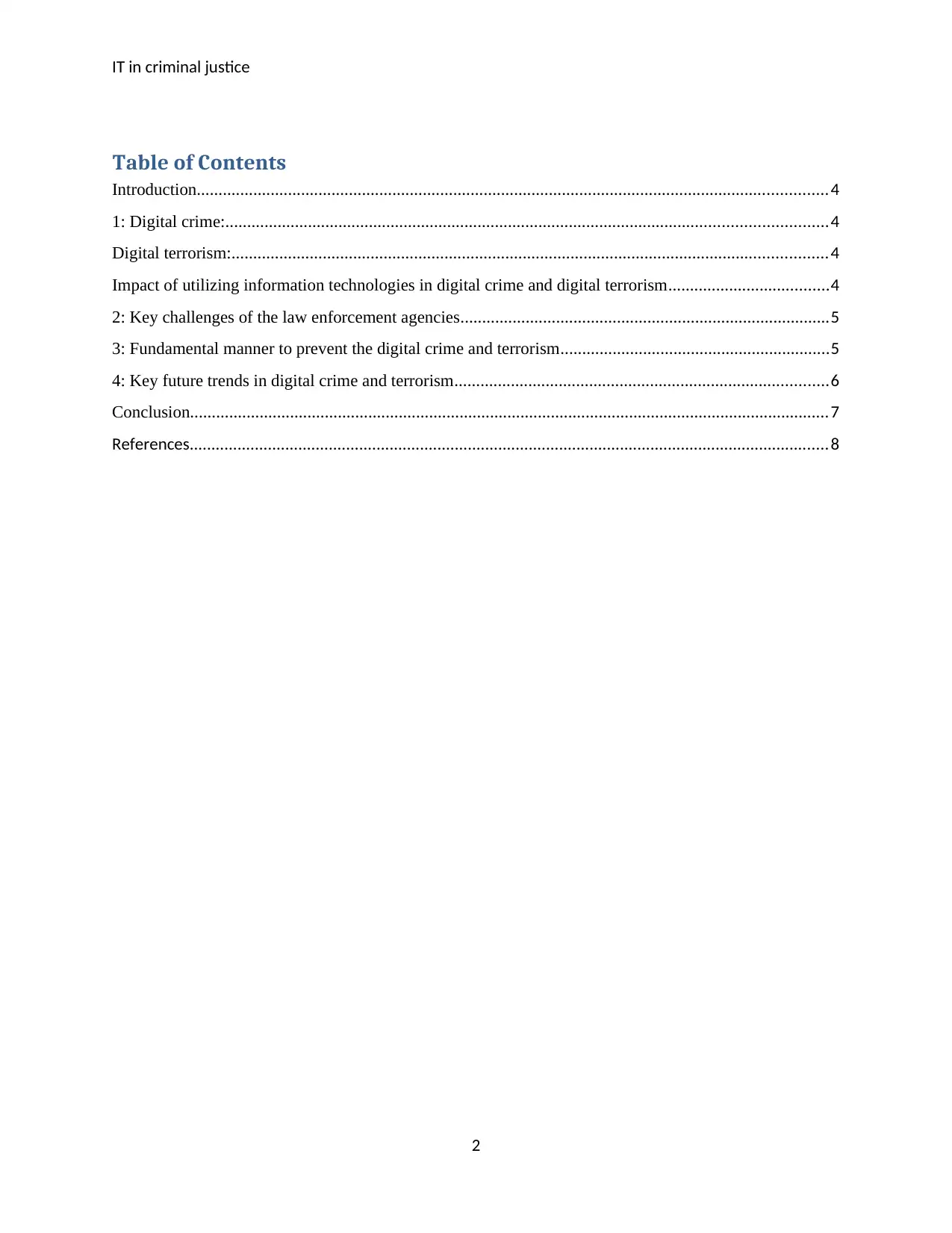
IT in criminal justice
Table of Contents
Introduction.................................................................................................................................................4
1: Digital crime:..........................................................................................................................................4
Digital terrorism:.........................................................................................................................................4
Impact of utilizing information technologies in digital crime and digital terrorism.....................................4
2: Key challenges of the law enforcement agencies.....................................................................................5
3: Fundamental manner to prevent the digital crime and terrorism..............................................................5
4: Key future trends in digital crime and terrorism......................................................................................6
Conclusion...................................................................................................................................................7
References...................................................................................................................................................8
2
Table of Contents
Introduction.................................................................................................................................................4
1: Digital crime:..........................................................................................................................................4
Digital terrorism:.........................................................................................................................................4
Impact of utilizing information technologies in digital crime and digital terrorism.....................................4
2: Key challenges of the law enforcement agencies.....................................................................................5
3: Fundamental manner to prevent the digital crime and terrorism..............................................................5
4: Key future trends in digital crime and terrorism......................................................................................6
Conclusion...................................................................................................................................................7
References...................................................................................................................................................8
2
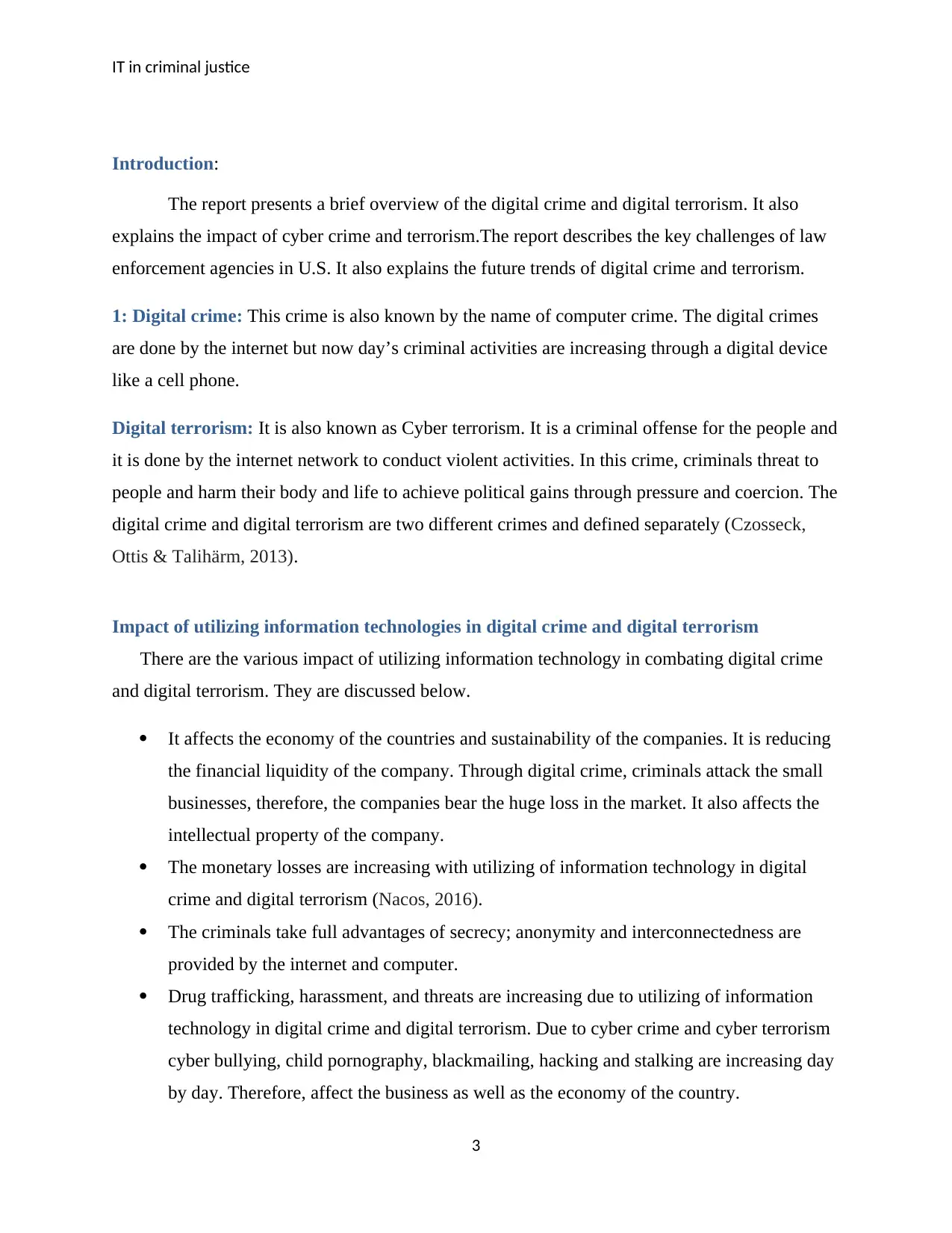
IT in criminal justice
Introduction:
The report presents a brief overview of the digital crime and digital terrorism. It also
explains the impact of cyber crime and terrorism.The report describes the key challenges of law
enforcement agencies in U.S. It also explains the future trends of digital crime and terrorism.
1: Digital crime: This crime is also known by the name of computer crime. The digital crimes
are done by the internet but now day’s criminal activities are increasing through a digital device
like a cell phone.
Digital terrorism: It is also known as Cyber terrorism. It is a criminal offense for the people and
it is done by the internet network to conduct violent activities. In this crime, criminals threat to
people and harm their body and life to achieve political gains through pressure and coercion. The
digital crime and digital terrorism are two different crimes and defined separately (Czosseck,
Ottis & Talihärm, 2013).
Impact of utilizing information technologies in digital crime and digital terrorism
There are the various impact of utilizing information technology in combating digital crime
and digital terrorism. They are discussed below.
It affects the economy of the countries and sustainability of the companies. It is reducing
the financial liquidity of the company. Through digital crime, criminals attack the small
businesses, therefore, the companies bear the huge loss in the market. It also affects the
intellectual property of the company.
The monetary losses are increasing with utilizing of information technology in digital
crime and digital terrorism (Nacos, 2016).
The criminals take full advantages of secrecy; anonymity and interconnectedness are
provided by the internet and computer.
Drug trafficking, harassment, and threats are increasing due to utilizing of information
technology in digital crime and digital terrorism. Due to cyber crime and cyber terrorism
cyber bullying, child pornography, blackmailing, hacking and stalking are increasing day
by day. Therefore, affect the business as well as the economy of the country.
3
Introduction:
The report presents a brief overview of the digital crime and digital terrorism. It also
explains the impact of cyber crime and terrorism.The report describes the key challenges of law
enforcement agencies in U.S. It also explains the future trends of digital crime and terrorism.
1: Digital crime: This crime is also known by the name of computer crime. The digital crimes
are done by the internet but now day’s criminal activities are increasing through a digital device
like a cell phone.
Digital terrorism: It is also known as Cyber terrorism. It is a criminal offense for the people and
it is done by the internet network to conduct violent activities. In this crime, criminals threat to
people and harm their body and life to achieve political gains through pressure and coercion. The
digital crime and digital terrorism are two different crimes and defined separately (Czosseck,
Ottis & Talihärm, 2013).
Impact of utilizing information technologies in digital crime and digital terrorism
There are the various impact of utilizing information technology in combating digital crime
and digital terrorism. They are discussed below.
It affects the economy of the countries and sustainability of the companies. It is reducing
the financial liquidity of the company. Through digital crime, criminals attack the small
businesses, therefore, the companies bear the huge loss in the market. It also affects the
intellectual property of the company.
The monetary losses are increasing with utilizing of information technology in digital
crime and digital terrorism (Nacos, 2016).
The criminals take full advantages of secrecy; anonymity and interconnectedness are
provided by the internet and computer.
Drug trafficking, harassment, and threats are increasing due to utilizing of information
technology in digital crime and digital terrorism. Due to cyber crime and cyber terrorism
cyber bullying, child pornography, blackmailing, hacking and stalking are increasing day
by day. Therefore, affect the business as well as the economy of the country.
3
⊘ This is a preview!⊘
Do you want full access?
Subscribe today to unlock all pages.

Trusted by 1+ million students worldwide
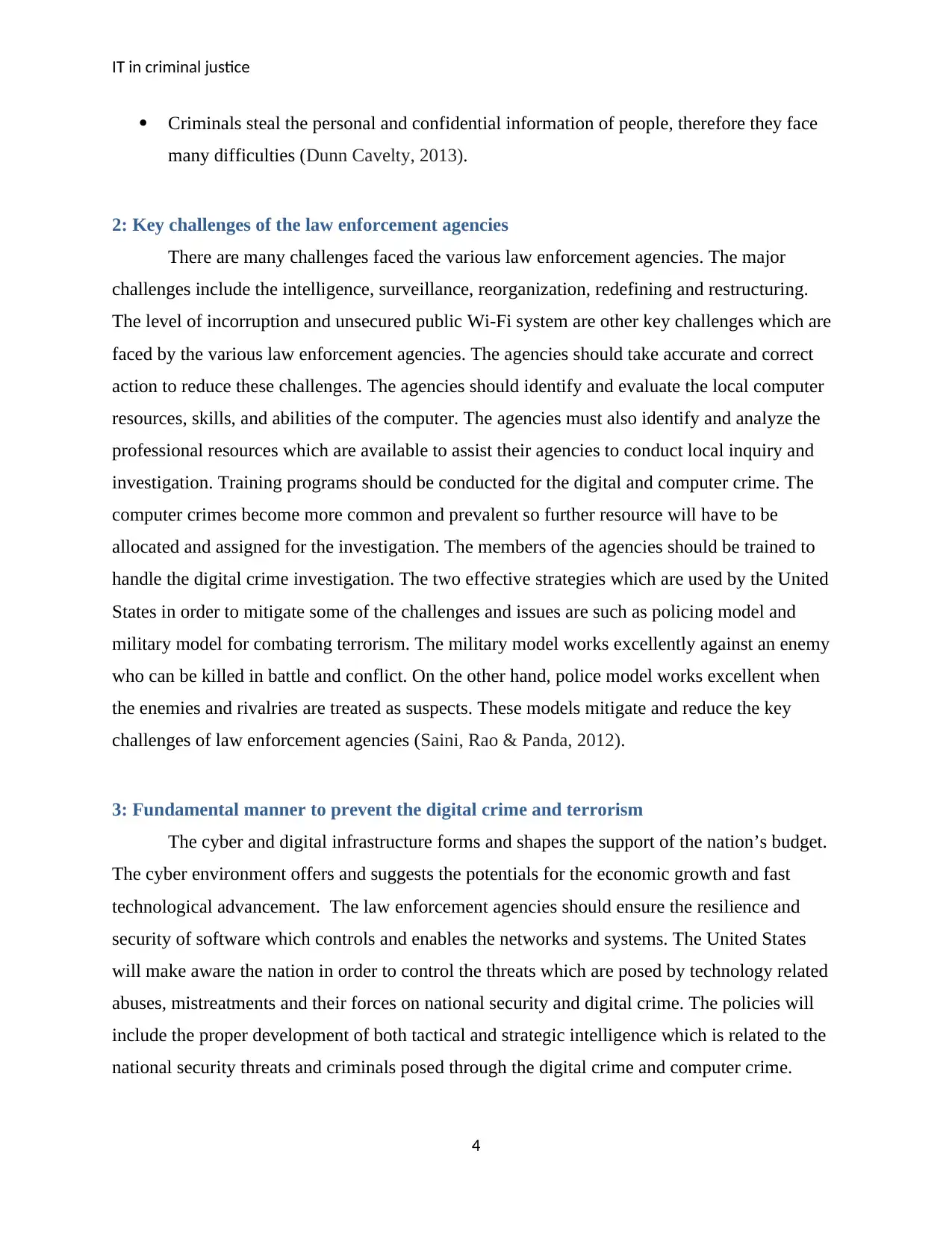
IT in criminal justice
Criminals steal the personal and confidential information of people, therefore they face
many difficulties (Dunn Cavelty, 2013).
2: Key challenges of the law enforcement agencies
There are many challenges faced the various law enforcement agencies. The major
challenges include the intelligence, surveillance, reorganization, redefining and restructuring.
The level of incorruption and unsecured public Wi-Fi system are other key challenges which are
faced by the various law enforcement agencies. The agencies should take accurate and correct
action to reduce these challenges. The agencies should identify and evaluate the local computer
resources, skills, and abilities of the computer. The agencies must also identify and analyze the
professional resources which are available to assist their agencies to conduct local inquiry and
investigation. Training programs should be conducted for the digital and computer crime. The
computer crimes become more common and prevalent so further resource will have to be
allocated and assigned for the investigation. The members of the agencies should be trained to
handle the digital crime investigation. The two effective strategies which are used by the United
States in order to mitigate some of the challenges and issues are such as policing model and
military model for combating terrorism. The military model works excellently against an enemy
who can be killed in battle and conflict. On the other hand, police model works excellent when
the enemies and rivalries are treated as suspects. These models mitigate and reduce the key
challenges of law enforcement agencies (Saini, Rao & Panda, 2012).
3: Fundamental manner to prevent the digital crime and terrorism
The cyber and digital infrastructure forms and shapes the support of the nation’s budget.
The cyber environment offers and suggests the potentials for the economic growth and fast
technological advancement. The law enforcement agencies should ensure the resilience and
security of software which controls and enables the networks and systems. The United States
will make aware the nation in order to control the threats which are posed by technology related
abuses, mistreatments and their forces on national security and digital crime. The policies will
include the proper development of both tactical and strategic intelligence which is related to the
national security threats and criminals posed through the digital crime and computer crime.
4
Criminals steal the personal and confidential information of people, therefore they face
many difficulties (Dunn Cavelty, 2013).
2: Key challenges of the law enforcement agencies
There are many challenges faced the various law enforcement agencies. The major
challenges include the intelligence, surveillance, reorganization, redefining and restructuring.
The level of incorruption and unsecured public Wi-Fi system are other key challenges which are
faced by the various law enforcement agencies. The agencies should take accurate and correct
action to reduce these challenges. The agencies should identify and evaluate the local computer
resources, skills, and abilities of the computer. The agencies must also identify and analyze the
professional resources which are available to assist their agencies to conduct local inquiry and
investigation. Training programs should be conducted for the digital and computer crime. The
computer crimes become more common and prevalent so further resource will have to be
allocated and assigned for the investigation. The members of the agencies should be trained to
handle the digital crime investigation. The two effective strategies which are used by the United
States in order to mitigate some of the challenges and issues are such as policing model and
military model for combating terrorism. The military model works excellently against an enemy
who can be killed in battle and conflict. On the other hand, police model works excellent when
the enemies and rivalries are treated as suspects. These models mitigate and reduce the key
challenges of law enforcement agencies (Saini, Rao & Panda, 2012).
3: Fundamental manner to prevent the digital crime and terrorism
The cyber and digital infrastructure forms and shapes the support of the nation’s budget.
The cyber environment offers and suggests the potentials for the economic growth and fast
technological advancement. The law enforcement agencies should ensure the resilience and
security of software which controls and enables the networks and systems. The United States
will make aware the nation in order to control the threats which are posed by technology related
abuses, mistreatments and their forces on national security and digital crime. The policies will
include the proper development of both tactical and strategic intelligence which is related to the
national security threats and criminals posed through the digital crime and computer crime.
4
Paraphrase This Document
Need a fresh take? Get an instant paraphrase of this document with our AI Paraphraser
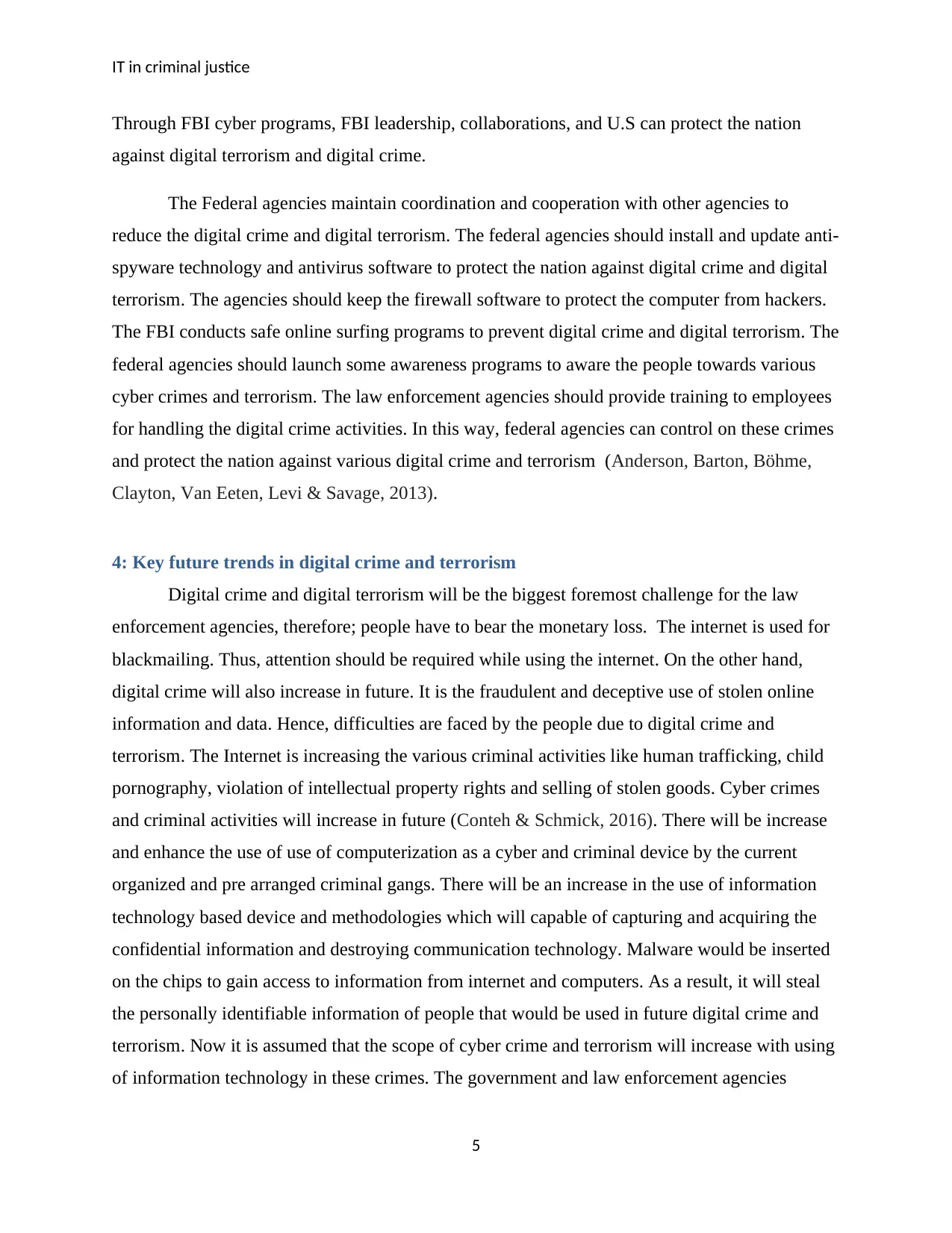
IT in criminal justice
Through FBI cyber programs, FBI leadership, collaborations, and U.S can protect the nation
against digital terrorism and digital crime.
The Federal agencies maintain coordination and cooperation with other agencies to
reduce the digital crime and digital terrorism. The federal agencies should install and update anti-
spyware technology and antivirus software to protect the nation against digital crime and digital
terrorism. The agencies should keep the firewall software to protect the computer from hackers.
The FBI conducts safe online surfing programs to prevent digital crime and digital terrorism. The
federal agencies should launch some awareness programs to aware the people towards various
cyber crimes and terrorism. The law enforcement agencies should provide training to employees
for handling the digital crime activities. In this way, federal agencies can control on these crimes
and protect the nation against various digital crime and terrorism (Anderson, Barton, Böhme,
Clayton, Van Eeten, Levi & Savage, 2013).
4: Key future trends in digital crime and terrorism
Digital crime and digital terrorism will be the biggest foremost challenge for the law
enforcement agencies, therefore; people have to bear the monetary loss. The internet is used for
blackmailing. Thus, attention should be required while using the internet. On the other hand,
digital crime will also increase in future. It is the fraudulent and deceptive use of stolen online
information and data. Hence, difficulties are faced by the people due to digital crime and
terrorism. The Internet is increasing the various criminal activities like human trafficking, child
pornography, violation of intellectual property rights and selling of stolen goods. Cyber crimes
and criminal activities will increase in future (Conteh & Schmick, 2016). There will be increase
and enhance the use of use of computerization as a cyber and criminal device by the current
organized and pre arranged criminal gangs. There will be an increase in the use of information
technology based device and methodologies which will capable of capturing and acquiring the
confidential information and destroying communication technology. Malware would be inserted
on the chips to gain access to information from internet and computers. As a result, it will steal
the personally identifiable information of people that would be used in future digital crime and
terrorism. Now it is assumed that the scope of cyber crime and terrorism will increase with using
of information technology in these crimes. The government and law enforcement agencies
5
Through FBI cyber programs, FBI leadership, collaborations, and U.S can protect the nation
against digital terrorism and digital crime.
The Federal agencies maintain coordination and cooperation with other agencies to
reduce the digital crime and digital terrorism. The federal agencies should install and update anti-
spyware technology and antivirus software to protect the nation against digital crime and digital
terrorism. The agencies should keep the firewall software to protect the computer from hackers.
The FBI conducts safe online surfing programs to prevent digital crime and digital terrorism. The
federal agencies should launch some awareness programs to aware the people towards various
cyber crimes and terrorism. The law enforcement agencies should provide training to employees
for handling the digital crime activities. In this way, federal agencies can control on these crimes
and protect the nation against various digital crime and terrorism (Anderson, Barton, Böhme,
Clayton, Van Eeten, Levi & Savage, 2013).
4: Key future trends in digital crime and terrorism
Digital crime and digital terrorism will be the biggest foremost challenge for the law
enforcement agencies, therefore; people have to bear the monetary loss. The internet is used for
blackmailing. Thus, attention should be required while using the internet. On the other hand,
digital crime will also increase in future. It is the fraudulent and deceptive use of stolen online
information and data. Hence, difficulties are faced by the people due to digital crime and
terrorism. The Internet is increasing the various criminal activities like human trafficking, child
pornography, violation of intellectual property rights and selling of stolen goods. Cyber crimes
and criminal activities will increase in future (Conteh & Schmick, 2016). There will be increase
and enhance the use of use of computerization as a cyber and criminal device by the current
organized and pre arranged criminal gangs. There will be an increase in the use of information
technology based device and methodologies which will capable of capturing and acquiring the
confidential information and destroying communication technology. Malware would be inserted
on the chips to gain access to information from internet and computers. As a result, it will steal
the personally identifiable information of people that would be used in future digital crime and
terrorism. Now it is assumed that the scope of cyber crime and terrorism will increase with using
of information technology in these crimes. The government and law enforcement agencies
5
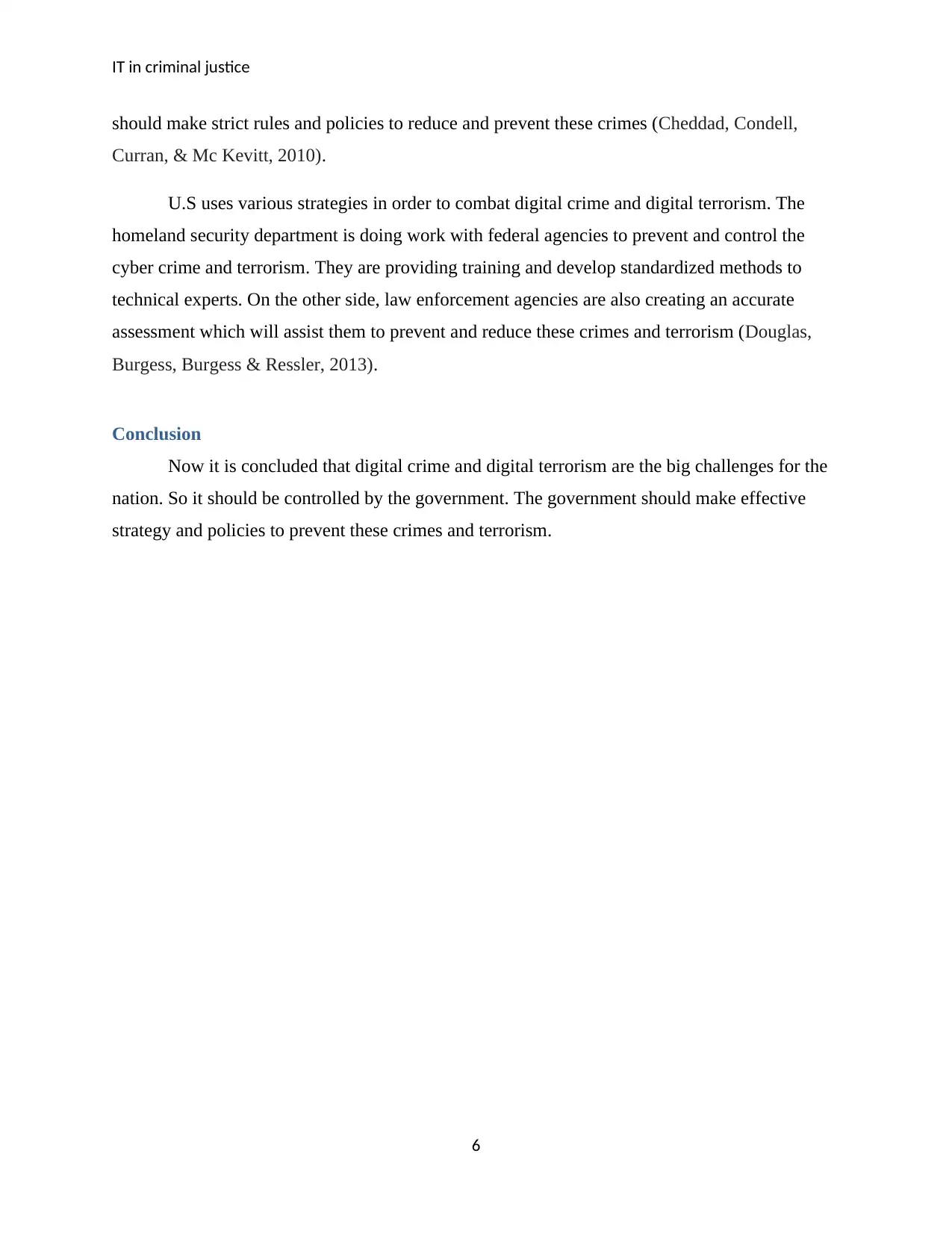
IT in criminal justice
should make strict rules and policies to reduce and prevent these crimes (Cheddad, Condell,
Curran, & Mc Kevitt, 2010).
U.S uses various strategies in order to combat digital crime and digital terrorism. The
homeland security department is doing work with federal agencies to prevent and control the
cyber crime and terrorism. They are providing training and develop standardized methods to
technical experts. On the other side, law enforcement agencies are also creating an accurate
assessment which will assist them to prevent and reduce these crimes and terrorism (Douglas,
Burgess, Burgess & Ressler, 2013).
Conclusion
Now it is concluded that digital crime and digital terrorism are the big challenges for the
nation. So it should be controlled by the government. The government should make effective
strategy and policies to prevent these crimes and terrorism.
6
should make strict rules and policies to reduce and prevent these crimes (Cheddad, Condell,
Curran, & Mc Kevitt, 2010).
U.S uses various strategies in order to combat digital crime and digital terrorism. The
homeland security department is doing work with federal agencies to prevent and control the
cyber crime and terrorism. They are providing training and develop standardized methods to
technical experts. On the other side, law enforcement agencies are also creating an accurate
assessment which will assist them to prevent and reduce these crimes and terrorism (Douglas,
Burgess, Burgess & Ressler, 2013).
Conclusion
Now it is concluded that digital crime and digital terrorism are the big challenges for the
nation. So it should be controlled by the government. The government should make effective
strategy and policies to prevent these crimes and terrorism.
6
⊘ This is a preview!⊘
Do you want full access?
Subscribe today to unlock all pages.

Trusted by 1+ million students worldwide
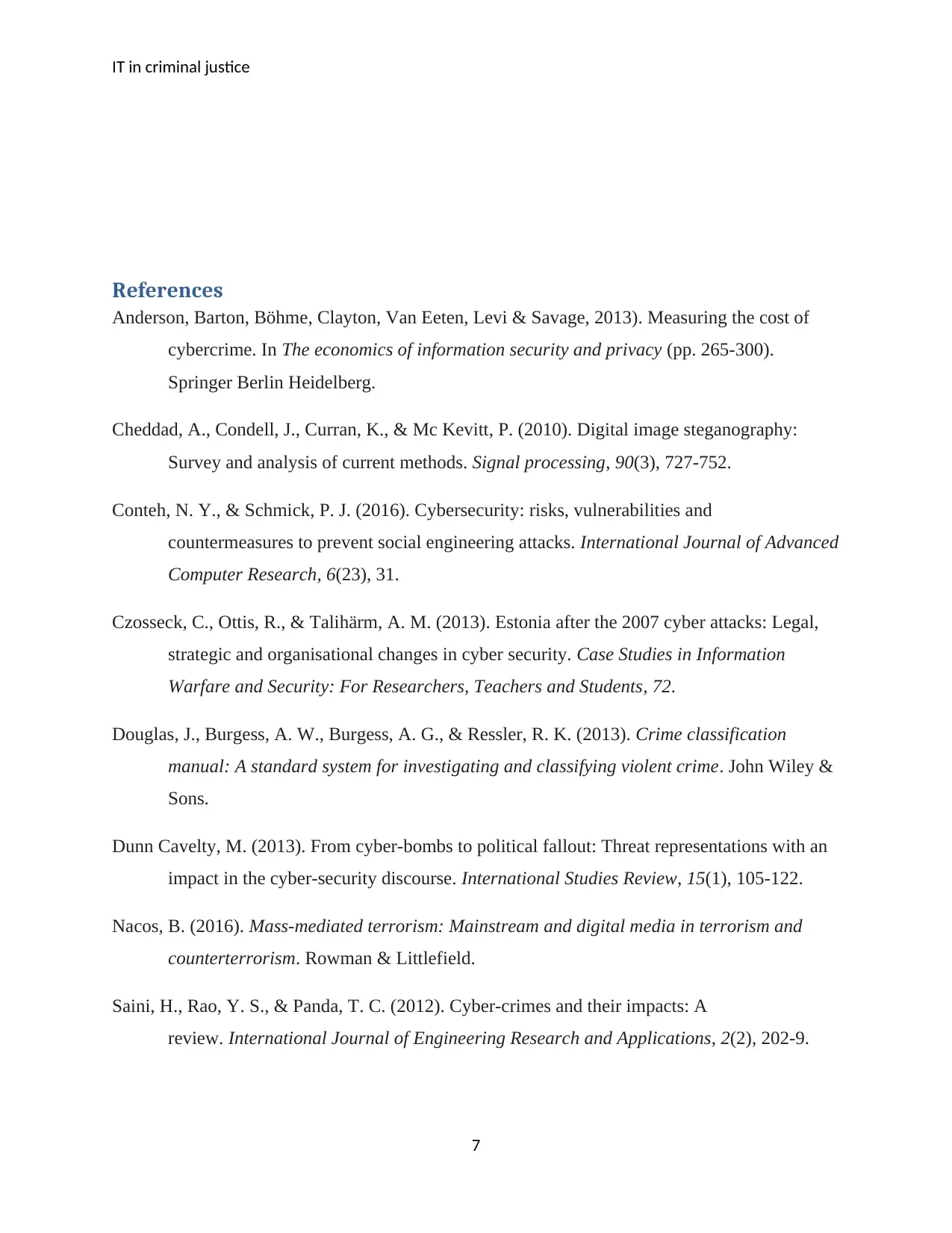
IT in criminal justice
References
Anderson, Barton, Böhme, Clayton, Van Eeten, Levi & Savage, 2013). Measuring the cost of
cybercrime. In The economics of information security and privacy (pp. 265-300).
Springer Berlin Heidelberg.
Cheddad, A., Condell, J., Curran, K., & Mc Kevitt, P. (2010). Digital image steganography:
Survey and analysis of current methods. Signal processing, 90(3), 727-752.
Conteh, N. Y., & Schmick, P. J. (2016). Cybersecurity: risks, vulnerabilities and
countermeasures to prevent social engineering attacks. International Journal of Advanced
Computer Research, 6(23), 31.
Czosseck, C., Ottis, R., & Talihärm, A. M. (2013). Estonia after the 2007 cyber attacks: Legal,
strategic and organisational changes in cyber security. Case Studies in Information
Warfare and Security: For Researchers, Teachers and Students, 72.
Douglas, J., Burgess, A. W., Burgess, A. G., & Ressler, R. K. (2013). Crime classification
manual: A standard system for investigating and classifying violent crime. John Wiley &
Sons.
Dunn Cavelty, M. (2013). From cyber-bombs to political fallout: Threat representations with an
impact in the cyber-security discourse. International Studies Review, 15(1), 105-122.
Nacos, B. (2016). Mass-mediated terrorism: Mainstream and digital media in terrorism and
counterterrorism. Rowman & Littlefield.
Saini, H., Rao, Y. S., & Panda, T. C. (2012). Cyber-crimes and their impacts: A
review. International Journal of Engineering Research and Applications, 2(2), 202-9.
7
References
Anderson, Barton, Böhme, Clayton, Van Eeten, Levi & Savage, 2013). Measuring the cost of
cybercrime. In The economics of information security and privacy (pp. 265-300).
Springer Berlin Heidelberg.
Cheddad, A., Condell, J., Curran, K., & Mc Kevitt, P. (2010). Digital image steganography:
Survey and analysis of current methods. Signal processing, 90(3), 727-752.
Conteh, N. Y., & Schmick, P. J. (2016). Cybersecurity: risks, vulnerabilities and
countermeasures to prevent social engineering attacks. International Journal of Advanced
Computer Research, 6(23), 31.
Czosseck, C., Ottis, R., & Talihärm, A. M. (2013). Estonia after the 2007 cyber attacks: Legal,
strategic and organisational changes in cyber security. Case Studies in Information
Warfare and Security: For Researchers, Teachers and Students, 72.
Douglas, J., Burgess, A. W., Burgess, A. G., & Ressler, R. K. (2013). Crime classification
manual: A standard system for investigating and classifying violent crime. John Wiley &
Sons.
Dunn Cavelty, M. (2013). From cyber-bombs to political fallout: Threat representations with an
impact in the cyber-security discourse. International Studies Review, 15(1), 105-122.
Nacos, B. (2016). Mass-mediated terrorism: Mainstream and digital media in terrorism and
counterterrorism. Rowman & Littlefield.
Saini, H., Rao, Y. S., & Panda, T. C. (2012). Cyber-crimes and their impacts: A
review. International Journal of Engineering Research and Applications, 2(2), 202-9.
7
1 out of 7
Related Documents
Your All-in-One AI-Powered Toolkit for Academic Success.
+13062052269
info@desklib.com
Available 24*7 on WhatsApp / Email
![[object Object]](/_next/static/media/star-bottom.7253800d.svg)
Unlock your academic potential
Copyright © 2020–2025 A2Z Services. All Rights Reserved. Developed and managed by ZUCOL.




